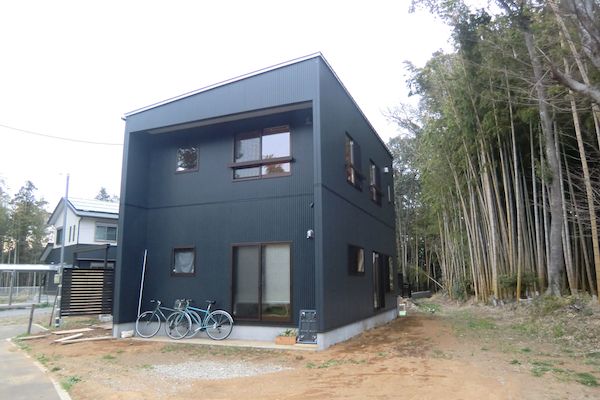 The move was relatively straightforward and painless, and even cleaning up the apartment turned out to be less of a hassle that it’s been at other apartments when we left, mainly due to the fact that we were only there a little more than two-and-a-half years.
The move was relatively straightforward and painless, and even cleaning up the apartment turned out to be less of a hassle that it’s been at other apartments when we left, mainly due to the fact that we were only there a little more than two-and-a-half years.
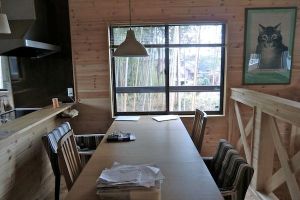 But the settling-in has taken time; not so much the arranging of furniture and figuring out storage options, but wondering about all the stuff we told A-1 we didn’t need because we were going to do all that ourselves. As mentioned previously, we had no real idea what the place would look like once it was finished, so we didn’t want to predecorate it and then later find out that it didn’t work; which is the way most people go about building a house. In the weeks leading up to the move we had bought shelves and racks and lights and curtain rods and curtains as we assessed the interior during its evolution into living space. We still needed blinds on all the windows, floor coverings, ceiling fans–not to mention extra counter space, since all we had was the kitchen island on the second floor. Though we aren’t huge fans of Ikea, we decided to do a run on the home furnishings monolith since it would just be easier to order what we needed all in one place and have it delivered all at one time. As usually happens when people go there, we left exhausted, frustrated, and a little abashed at the fact that we had let the place get to us. But we found most of the stuff we needed.
But the settling-in has taken time; not so much the arranging of furniture and figuring out storage options, but wondering about all the stuff we told A-1 we didn’t need because we were going to do all that ourselves. As mentioned previously, we had no real idea what the place would look like once it was finished, so we didn’t want to predecorate it and then later find out that it didn’t work; which is the way most people go about building a house. In the weeks leading up to the move we had bought shelves and racks and lights and curtain rods and curtains as we assessed the interior during its evolution into living space. We still needed blinds on all the windows, floor coverings, ceiling fans–not to mention extra counter space, since all we had was the kitchen island on the second floor. Though we aren’t huge fans of Ikea, we decided to do a run on the home furnishings monolith since it would just be easier to order what we needed all in one place and have it delivered all at one time. As usually happens when people go there, we left exhausted, frustrated, and a little abashed at the fact that we had let the place get to us. But we found most of the stuff we needed.
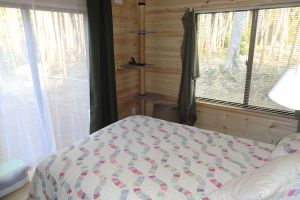 We ordered one set of drapes for the bedroom at Mujirushi, but their blinds were over-priced, we thought, and there wasn’t much of a selection in terms of colors. So we went to Nitori, a home furnishings store that’s a notch or two below Muji in terms of stylistic cachet. We were quite pleasantly surprised with the selection of blinds–about a hundred different colors–and they could custom make each set to the exact specifications of the windows, which were all different sizes. Nine sets came to a little more than ¥100,000. Later we ordered lace curtains for the smaller windows on the north side of the house, 7 in all, and it was less than ¥20,000. For the two square windows in the “living room” (more of a nook) we bought Japanese noren–the curtains that hang at the entrances to restaurants and public baths–and put them over the windows suspended from pipe we bought at our local DIY store.
We ordered one set of drapes for the bedroom at Mujirushi, but their blinds were over-priced, we thought, and there wasn’t much of a selection in terms of colors. So we went to Nitori, a home furnishings store that’s a notch or two below Muji in terms of stylistic cachet. We were quite pleasantly surprised with the selection of blinds–about a hundred different colors–and they could custom make each set to the exact specifications of the windows, which were all different sizes. Nine sets came to a little more than ¥100,000. Later we ordered lace curtains for the smaller windows on the north side of the house, 7 in all, and it was less than ¥20,000. For the two square windows in the “living room” (more of a nook) we bought Japanese noren–the curtains that hang at the entrances to restaurants and public baths–and put them over the windows suspended from pipe we bought at our local DIY store.
 The ceiling fans took more thought. We are not going to have air conditioning in the house, with the hope that since we are surrounded by forest the vegetation will make electrically induced cooling unnecessary. But we still need air circulation, meaning three ceiling fans on the first floor and two on the second, and made sure A-1 installed rosettes in the proper places. We checked the power consumption of the units we already owned against the newer ones on the market and found that fans which use DC motors consume only a fraction of what conventional ceiling fans do, and appear to be quieter as well. The newer of our two existing fans, made by NEC, apparently uses quite a bit of electricity when we checked the specs on the Internet, but the other one, made by Odelic, was pretty efficient, even if it didn’t use a DC motor, so we threw out the NEC, kept the Odelic, and ordered four DC fans made by Daiko from a distributor in Kyoto. They arrived quickly. The two on the first floor we could install ourselves, but the ones for the second floor were trickier, because the ceiling is angled. We have to use extension pipes which meant fooling around with the electrical work. Likewise, the Odelic fan that would be installed in the first floor office would need electrical work as well, since the ceiling attachment was made for a different sort of rosette than the one A-1 had installed. We decided to hire a professional and first called the guy who had put up our antenna (which, by the way, had fallen down once already). We had to wait more than a week for him to come and when he did he looked at the fans, looked at the ceiling, shrugged, and admitted he’d never installed these kinds of fans before. Basically, he was trying to beg out of the job, and we wondered why he agreed to come in the first place, but we got the message and said we’d find someone else. So we went to the discount electronics store K’s Denki and asked if they could hook up the fans, even though we hadn’t bought them from their store. They said sure but we would have to negotiate with the contractor, which sounded strange. Apparently, K’s just acts as a paid go-between. They found an electrician for us and another week passed before he showed up. Like the earlier guy he had never installed this particular type of fan before, but he was game. It took him a full hour to install the first ceiling fan and than only five minutes to put in the second. Does that make the learning curve long or short? He also hooked up the Odelic fan by changing the rosette on the ceiling, and after he left we discovered that when you turned it on it emitted a continuous low hum that could be heard on the second floor. We should have just bought another Daiko fan and put that in the office, too.
The ceiling fans took more thought. We are not going to have air conditioning in the house, with the hope that since we are surrounded by forest the vegetation will make electrically induced cooling unnecessary. But we still need air circulation, meaning three ceiling fans on the first floor and two on the second, and made sure A-1 installed rosettes in the proper places. We checked the power consumption of the units we already owned against the newer ones on the market and found that fans which use DC motors consume only a fraction of what conventional ceiling fans do, and appear to be quieter as well. The newer of our two existing fans, made by NEC, apparently uses quite a bit of electricity when we checked the specs on the Internet, but the other one, made by Odelic, was pretty efficient, even if it didn’t use a DC motor, so we threw out the NEC, kept the Odelic, and ordered four DC fans made by Daiko from a distributor in Kyoto. They arrived quickly. The two on the first floor we could install ourselves, but the ones for the second floor were trickier, because the ceiling is angled. We have to use extension pipes which meant fooling around with the electrical work. Likewise, the Odelic fan that would be installed in the first floor office would need electrical work as well, since the ceiling attachment was made for a different sort of rosette than the one A-1 had installed. We decided to hire a professional and first called the guy who had put up our antenna (which, by the way, had fallen down once already). We had to wait more than a week for him to come and when he did he looked at the fans, looked at the ceiling, shrugged, and admitted he’d never installed these kinds of fans before. Basically, he was trying to beg out of the job, and we wondered why he agreed to come in the first place, but we got the message and said we’d find someone else. So we went to the discount electronics store K’s Denki and asked if they could hook up the fans, even though we hadn’t bought them from their store. They said sure but we would have to negotiate with the contractor, which sounded strange. Apparently, K’s just acts as a paid go-between. They found an electrician for us and another week passed before he showed up. Like the earlier guy he had never installed this particular type of fan before, but he was game. It took him a full hour to install the first ceiling fan and than only five minutes to put in the second. Does that make the learning curve long or short? He also hooked up the Odelic fan by changing the rosette on the ceiling, and after he left we discovered that when you turned it on it emitted a continuous low hum that could be heard on the second floor. We should have just bought another Daiko fan and put that in the office, too.
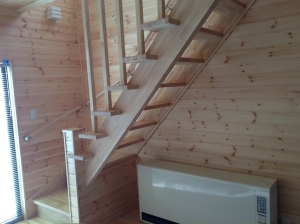 For the first two months the temperature was still pretty low, so we found out how the heaters worked. As mentioned in the previous post, using storage heaters is a predictive art. You have to know what the temperature will be the next day so that you can set the level of heat storage accordingly. In the beginning we set both heaters on high, the result being that the second floor was balmy all the time and the first was comfortable but only in spots. As the salesperson had warned us when we were deciding where to install them, putting a heater on the first floor under the stairs was not the most efficient choice, since the heat would just rise up the stairwell to the second floor, but there was no other available space on the first floor for such a large device so that’s where we set it. We eventually hit on a system of keeping the first floor unit up high and the second floor one on medium, and after a week or so the house itself seemed to adjust to the way the heat moved. And once the ceiling fans were installed it became easier to control the temperature on the first floor, since the fans distributed the air more evenly through the whole house. It was the first time since we had lived together in Japan that we could move from room to room without changing clothes or turning on/off space heaters. Except for parts of the office, the whole house was a uniform temperature, all the time. We were particularly pleased with the bathroom, since it seems every place we’ve lived in the bathroom is always freezing. Once the weather became warmer we had to readjust again, but we’re getting to the point where we can understand the system. We were nervous about the bill, and while it turned out to be higher than the last electric bill we paid at our previous apartment, it was significantly lower than the sum of both the electricity and the gas, so in the end we’re saving about 20 percent on utilities.
For the first two months the temperature was still pretty low, so we found out how the heaters worked. As mentioned in the previous post, using storage heaters is a predictive art. You have to know what the temperature will be the next day so that you can set the level of heat storage accordingly. In the beginning we set both heaters on high, the result being that the second floor was balmy all the time and the first was comfortable but only in spots. As the salesperson had warned us when we were deciding where to install them, putting a heater on the first floor under the stairs was not the most efficient choice, since the heat would just rise up the stairwell to the second floor, but there was no other available space on the first floor for such a large device so that’s where we set it. We eventually hit on a system of keeping the first floor unit up high and the second floor one on medium, and after a week or so the house itself seemed to adjust to the way the heat moved. And once the ceiling fans were installed it became easier to control the temperature on the first floor, since the fans distributed the air more evenly through the whole house. It was the first time since we had lived together in Japan that we could move from room to room without changing clothes or turning on/off space heaters. Except for parts of the office, the whole house was a uniform temperature, all the time. We were particularly pleased with the bathroom, since it seems every place we’ve lived in the bathroom is always freezing. Once the weather became warmer we had to readjust again, but we’re getting to the point where we can understand the system. We were nervous about the bill, and while it turned out to be higher than the last electric bill we paid at our previous apartment, it was significantly lower than the sum of both the electricity and the gas, so in the end we’re saving about 20 percent on utilities.
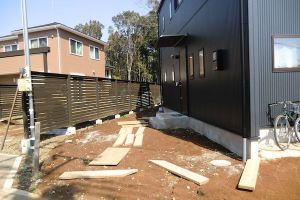 In that regard, the house seems pretty airtight. No drafts or leaks, and we’ve already gone through several heavy rainstorms and even one blizzard. In fact, for almost two months we hardly had to dust. The only problem in this area was the genkan, which is all unfinished, uncovered concrete. After a few rain showers, the concrete became wet, as if water were seeping into it from below. One day there was even standing water in the corner. We called Young N and told him and he sounded mystified. Later he came and checked the outside of the house to make sure there were no leaks in the plumbing, but it didn’t seem to have anything to do with the plumbing or even leaks from outside. Concrete, after all, is made with water, and it was more like the water content had simply sweated out of the set material. After two weeks, the water evaporated and the stain dried. It’s rained several times since then, a few times very heavily, but the stain has only come back once, and in a different corner, which makes us think it may be something that the concrete has to go through on its own. On the other hand, the outdoor stoop, which is basically the same block of concrete that makes up the genkan, is alredy webbed with small cracks. Young N says he’ll get around to fixing it, but first we would need to clean both the stoop and the genkan thoroughly. Since the landscaping still needs to be done, the house is surrounded by dirt that turns to mud with the slightest shower. We bought some brick units to lay on the ground so that we wouldn’t be tracking so much filth into the genkan, but it’s difficult. Until we get an approach built and some vegetation on the ground, it’s just a big pig sty.
In that regard, the house seems pretty airtight. No drafts or leaks, and we’ve already gone through several heavy rainstorms and even one blizzard. In fact, for almost two months we hardly had to dust. The only problem in this area was the genkan, which is all unfinished, uncovered concrete. After a few rain showers, the concrete became wet, as if water were seeping into it from below. One day there was even standing water in the corner. We called Young N and told him and he sounded mystified. Later he came and checked the outside of the house to make sure there were no leaks in the plumbing, but it didn’t seem to have anything to do with the plumbing or even leaks from outside. Concrete, after all, is made with water, and it was more like the water content had simply sweated out of the set material. After two weeks, the water evaporated and the stain dried. It’s rained several times since then, a few times very heavily, but the stain has only come back once, and in a different corner, which makes us think it may be something that the concrete has to go through on its own. On the other hand, the outdoor stoop, which is basically the same block of concrete that makes up the genkan, is alredy webbed with small cracks. Young N says he’ll get around to fixing it, but first we would need to clean both the stoop and the genkan thoroughly. Since the landscaping still needs to be done, the house is surrounded by dirt that turns to mud with the slightest shower. We bought some brick units to lay on the ground so that we wouldn’t be tracking so much filth into the genkan, but it’s difficult. Until we get an approach built and some vegetation on the ground, it’s just a big pig sty.
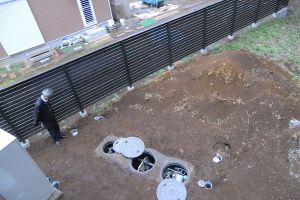 Since we use well water, that’s free as far as it goes. We don’t pay for city sewage, either, because there is none out here, but we do have to pay a contractor hired by the city to come and inspect our septic tanks twice a year, so it amounts to about the same thing. One day a guy from the city office came and gave us the speech, which turned out to be pretty sobering. Inba-numa, the lake to the east of us, is considered the second most polluted body of fresh water in Japan, mainly from agricultural runoff but also from effluent from home septic tanks. The one we had installed is state-of-the-art, so it should help cut down on waste that makes its way to the marshland, but we have to be careful: no dumping cooking oil or food waste into the sink or flushing just anything down the toilet. (Like cat litter, which we did at the apartment because the description on the bag said you could) A week later the technician came and opened up the septic tank, making sure it was working properly and even cleaning it. Nothing like owning a facility that could break down and cost you hundreds of thousands of yen to fix to make you more environmentally aware.
Since we use well water, that’s free as far as it goes. We don’t pay for city sewage, either, because there is none out here, but we do have to pay a contractor hired by the city to come and inspect our septic tanks twice a year, so it amounts to about the same thing. One day a guy from the city office came and gave us the speech, which turned out to be pretty sobering. Inba-numa, the lake to the east of us, is considered the second most polluted body of fresh water in Japan, mainly from agricultural runoff but also from effluent from home septic tanks. The one we had installed is state-of-the-art, so it should help cut down on waste that makes its way to the marshland, but we have to be careful: no dumping cooking oil or food waste into the sink or flushing just anything down the toilet. (Like cat litter, which we did at the apartment because the description on the bag said you could) A week later the technician came and opened up the septic tank, making sure it was working properly and even cleaning it. Nothing like owning a facility that could break down and cost you hundreds of thousands of yen to fix to make you more environmentally aware.
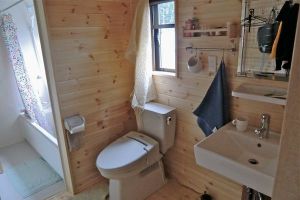 Though the water is perfectly safe to drink, it has a distinct phosphorous odor, which is great for hot springs but not for making tea. All the supermarkets near our house have purified water dispensing machines, some of them free as long as you buy a container, so we use that for drinking and cooking. But after a month or so we started using the tap water for the ice maker and didn’t notice any smell from the resulting ice. In fact, if you drink the water it doesn’t have a taste, only a smell, so we keep a pitcher of tap water on hand with pieces of charcoal to neutralize the smell and use that for tea. But the water is obviously filled with minerals. We’ve already had to change the shower head because it became clogged and wouldn’t spray properly, even after cleaning. The shower head we bought is easier to clean and has more holes. It seems to resist clogging. The joys and satisfactions of small purchases, of which there are obviously many more to come.
Though the water is perfectly safe to drink, it has a distinct phosphorous odor, which is great for hot springs but not for making tea. All the supermarkets near our house have purified water dispensing machines, some of them free as long as you buy a container, so we use that for drinking and cooking. But after a month or so we started using the tap water for the ice maker and didn’t notice any smell from the resulting ice. In fact, if you drink the water it doesn’t have a taste, only a smell, so we keep a pitcher of tap water on hand with pieces of charcoal to neutralize the smell and use that for tea. But the water is obviously filled with minerals. We’ve already had to change the shower head because it became clogged and wouldn’t spray properly, even after cleaning. The shower head we bought is easier to clean and has more holes. It seems to resist clogging. The joys and satisfactions of small purchases, of which there are obviously many more to come.
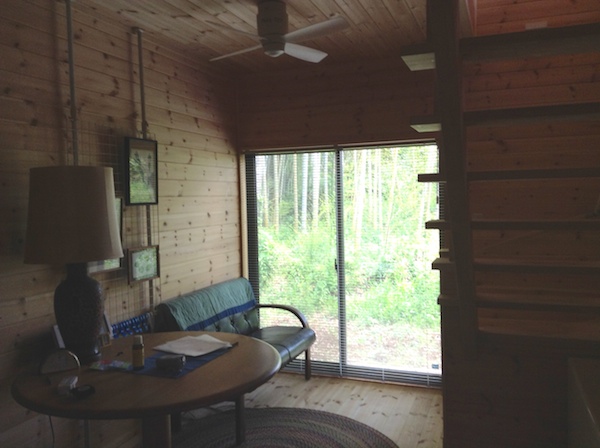

What a wonderful home! Congrats!
LikeLike
yeah I learned the hard way that IKEA is a dangerous place when you have a blank canvas to work with . . .
my first apartment coming back from having lived in Japan, I had money but no furniture!
IKEA solved both issues, LOL
But moving out 5 years later I didn’t watch the movers carefully enough and they destroyed several of the cabinets etc. since they’re pretty fragile.
Solar-powered AC seems to be a no-brainer, but I guess with Japan’s humid climate it’s not such a big win as in dry California.
LikeLike
Congratulations…..looks really comfortable. Nice to have some greenery as an outlook.
LikeLike
Checking in in your blog after a year and I’m so glad for you that you found a lovely home.
Note that the link you have on this page for the “Reconstructing 311” book is not working. Is it still available? Ebook?
LikeLike
Thanks. And thanks for pointing out the dead link. It was available as both an ebook and a print book, but Amazon doesn’t seem to carry either any more, and there isn’t much information at the publisher’s site either. Will have to check that out…
LikeLike
Congratulations, this is a brilliant living space, perfect for modern Japan. While it maybe small by Western standards the views are amazing, the finishing incredible and the use of wood makes the places on the inside look and feel so natural.
LikeLike
After following your essays for many years it is nice to see you reach that step, and I hope you settle in a nice way. Thank you for sharing all this info.
I am also looking into building and I have a very hard time figuring out how much the building will cost (I want to participate in the design). Like how much a bathroom or windows actually cost. This kind of info in available nowhere on the web, at least in english (actual cost from actual houses, not list prices or advertising). Would you please consider sharing a detailed financial breakdown of the building itself ? Please ! Thank you !
LikeLike
Nice house, the wood must’ve been expensive! I’ve been enjoying your columns and blogs for a while now. I bought a house a year ago and am renovating it myself I’m working on the last room now. Would like to contact you to get more info on markets and taxes.
LikeLike
Sweet office. Good luck with the future small purchases
LikeLike
Beautiful post! Love it! 🙂
http://JoshuaHideki.com/
LikeLike
When we had our house built 5 years ago, I found it was cheaper and easier to get the curtains done by the company, but not the blinds for the small windows which we did ourselves. Similarly with the light fittings; we bought our own and the company installed them. I have done all the landscaping here. The only real difference is time. 5 years to get it to look established, but I was able to choose and make things up as I go. My experience with the housing company showed me that you need to be *very* specific about what you want, or don’t want, and assume nothing.
LikeLike
Did you know IKEA was founded by and is ran by Nazis? Honestly, not kidding, google it up. Also they lie about being environment friendly… Plus their stuff is as low quality as it gets. We never ever even approach IKEA.
LikeLike